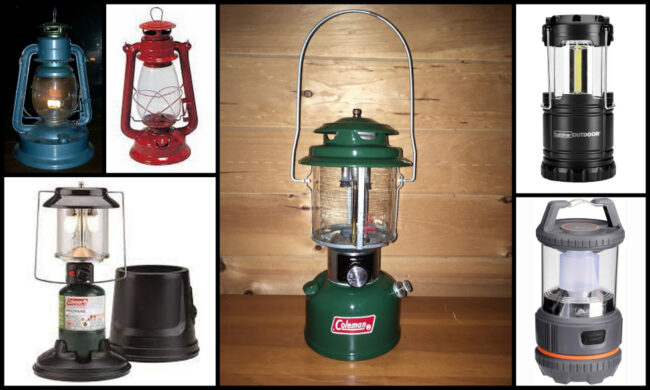Lighting
Once you’ve finally hit the trail, you’ll want to make sure that you can navigate around camp after sundown. This is one area where new technology has really made a difference.
In my early days of camping I carried the traditional US Army, D-cell flashlight. In later years I moved up to a Mini-Mag and a candle lantern.
In recent days however I’ve gravitated to LED technology. Unlike standard flashlights, the LED lamps convert all the energy they draw into light. No power is wasted making heat (as in the filament of a standard bulb). Add to that the fact that the white light produced is excellent for around-camp activities as well as night hiking. Besides much-improved burn time per battery, the lights can be much more lightweight than old-style lights.
Even so, I’m going to go into some detail on light sources in general because not everybody will want to use LED’s. I’ll start out with the oldest technology available in portable lighting, candles. Even with modern lights taking the lead in terms of popularity, there’s something very pleasant about using a candle lantern around your camp, especially if you’re backpacking. These come in various sizes and shapes but all do pretty much the same thing with similar output. If you decide to use a candle lantern, make sure it’s got a really good wind screen on it, otherwise you’ll be lighting and relighting it often.
Next up are lanterns. These too come in a variety of shapes and sizes, and in this category, also come with the ability to burn various fuels. Some use white gas, some propane, some petroleum-based fuels and some are electric. I don’t mind the electric or kerosene (or lamp oil), but the propane and white gas models are just plain noisy as they used pressurized then atomized fuel to burn. If you want a lot of light without the noise I guess LED lanterns are the way to go.
Probably the most well-known portable light source has to be a flashlight. These things go back over a century in terms of technology, but like everything else have evolved over time. Basically you’ve got some form of battery system and some form of bulb. The old incandescent work fine, but are somewhat dim and eat batteries alive. There are Florescent lights available, but they suffer the same drawbacks as the incandescent lamps. Most folks have gone to LED’s for all the same reasons already discussed.
Probably the most popular light source used by campers and hikers are headlamps. Some of these things are unbelievably bright and can light up huge areas at once on high output. I’ve had several models over the years and the one I have now has a single Cree bulb in it and three output settings. It’s got a super wide and even projection pattern which I really like. Some folks want a laser sharp spotlight beam, I do not. I love the wide and even lighting when doing chores around camp. One nice feature to have on any headlamp is the ability to tilt it downward. Sometimes you need to light up what’s nearby and the tilt function makes this possible.
A recent innovation to camp lighting has taken the form of rope LED lights. I own a Haven Tent and one of the accessories available is the “Ridgelight”. This literally runs along the ridge line of my hammock, attaches at both ends and is adjustable for both tension and output. It runs off of any USB battery source, and in my situation runs off the same battery that operates the micro air pump used to air up the mattress that goes into the hammock. Because it’s designed for my specific tent system, it’s been made in a way that the light and switch and battery work together beautifully in an integrated design. This is a great light source to have around your camp at night, makes it easy to get around away from the campfire if you need to be elsewhere.
I also carry a backup LED light in the form of a small flashlight. You can go almost anywhere and find these now at super low prices. The only real consideration on buying an LED light is battery life. If you buy an LED light with tons of bulbs that all burn the same time at high level, it’ll take you battery down quickly. For backcountry at least, look for a light that either has multiple “bulb on” settings or can dim a single bulb down to increase battery life.
Last modified on: February 24th 2022.




